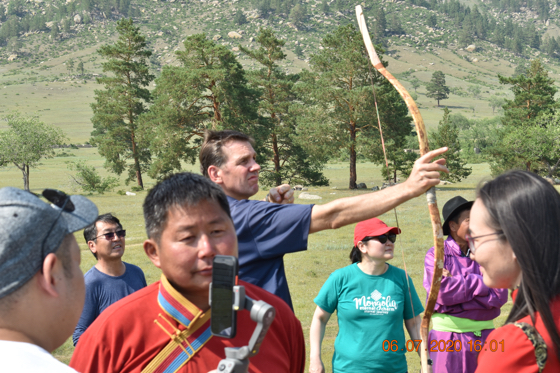GOSTELOW REPORT – “How to Google Meet to the world from a Mongolian tent 200 miles from my hotel was certainly not in the curriculum at hotel school,” said Dirk Bansemer, general manager of the 99-room Kempinski Hotel Khan Palace in Ulan Baator, capital of Mongolia.
Mongolia went into a virus lock-down from February 24 and this intrepid German, like so many of his colleagues globally, had a bit of spare time on his hands. He was out horseback riding with the local representative of Germany’s cultural trade mission, Deutsche Gesellschaft für Internationale Zusammenarbeit GmbH, usually called simply ‘GIZ.’ They hatched a plan to introduce Mongolia to a wider world. They knew this would be unique marketing at barely any financial outlay.

“On 6th of July, we drove around 200 miles to the distant steppes. GIZ, which provided a Toyota Land Cruiser and VW Touareg, introduced us to six families at Dulaan Khan Village in Selenge Province,” Bansemer explained. He was traveling with his male IT director and one of the signature Kempinski lobby hostesses (a Lady in Red), who took along her scarlet outfit for the actual streaming.
Mongolian villages are portable. ‘Houses,’ called ger or yurt, are felt-covered circular tents about 20 feet in diameter and as weather and animal migration demand they can easily be moved. Dulaan Khan Village has nine ger. One was given over, for this project, to Kempinski’s male team, another to ladies, from the hotel, and GIZ. Baggage included lots of tech equipment, plus a generator and a solar panel to supplement the village’s own power, which they correctly expected to be somewhat inconsistent.
“Kempinski’s Chief Commercial Officer Amanda Elder, still in lockdown in Dubai, invited all her teams worldwide to the event. As it turned out we had about 280 in seven sessions, 15-45 minutes long, from 3 p.m. through to noon the following day. It was interactive, certainly as far as Amanda Elder was concerned – she has since widely shared how she was ‘chatting’ with a septuagenarian male, in local dress, as he prepared such popular local Mongolian dishes as Khorkhog, bits of lamb, still on the bone, cooked with onions over hot stones. He also boiled milk to extract oil that the locals call “Urumi.” All participants also learned how to make, and use, bows and arrows.
“Our Lady in Red translated throughout. Like all the customer-facing team at the hotel, she speaks good English,” said Bansemer, explaining that he is the only foreigner in the entire complement of 135.
Kempinski Hotel Khan Palace, owned by the Tavan Bogd Group, is currently housing diplomats and others stranded by closed borders. It is usually filled 50-50 with business travelers and tourists, who come from United States, plus China, Japan, and many European countries, including Germany. Average length of leisure guests’ stay is 2.5 nights.
The follow-on effect has been phenomenal. Speaking from Delhi, India, Ankush Nijhawan, managing director of the Nijhawan Group, said he was truly inspired by ‘meeting’ Mongolian bow makers from the comfort of his lounge at home.
Bansemer said his own team members are tremendously proud that the world was learning about Mongolia. From his viewpoint, he has something to add to an unusual CV that already included managing a hotel in Kurdistan and he knows he has to do a repeat ger-yurt performance for those who missed that trial run.
